Double scaffolding is a framework in which two rows of standards connect through braces/ledgers and transoms. It is also known as Mason’s scaffolding or independent scaffolding. It provides a safe and stable platform that supports the weight of workers, tools, and materials. It is primarily used for stone masonry projects without wall support. Due to its complex structure, versatility, and high stability, it is suitable for high-rise construction, building restoration, and facade access.
The main benefits of double scaffolding are durability, a firmer base, independent support, support for heavy-duty work, and heavy-load capacity. The main uses of double scaffolding are reconstruction of tall buildings, masonry work, painting, decorating high structures, and installation of heavy equipment. The main parts of double scaffolding are standards, ledgers, braces, putlogs, planks, base plates, and guardrails.
Table of Contents
What is Double Scaffolding?
Double scaffolding is a temporary structure with double rows of standards and ledgers. It consists of two rows: one is the outer row, and the second is the inner row. The first or outer row is placed about 20 to 30 cm from the wall, while the inner row is set up around 1 meter from the first. Horizontal ledgers connect with standards at every level, and cross braces are added to enhance structural stability. Putlogs are installed on the structure so that both ends are supported through ledgers. You can’t drill into the walls and place putlogs.
Double scaffolding is also known as mason’s scaffolding, and is primarily used for stone masonry projects without wall support. The dual framework is created with double ledgers and standards, and thereby, this temporary structure provides high load-bearing capacity and offers a great amount of stability. Its additional stability due to an extra row makes it suitable for complex and large-scale construction projects.
What’s the Diagram of Double Scaffolding?

Double Scaffolding Images


What Are the Benefits of Double Scaffolding?
The twenty one primary benefits of Double scaffolding are as follows:
- Firmer base
- Independent support
- Durability
- Reusability
- Support for heavy-duty work
- Versatility
- Adaptability
- Ease of Access
- Enhanced Safety Features
- Enhanced Reliability
- Extended Reach and Increased height
- Enhanced workspace
- Multiple levels
- Improve Site mobility
- Enhanced productivity
- Reduce the risk of accidents
- Improve Worker Confidence
- Superior Resource Management
- Long-term Cost Effectiveness
- Resilience to Weather Conditions
- Compliance with Regulations
1. Firmer Base
The biggest benefit of double scaffolding is that it creates a stable base that workers can use safely. The overall frame has double standards and double ledgers, which make the overall working space more stable than a single scaffolding structure.
2. Independent Support
Double scaffolding doesn’t rely on a wall for its structural support. Since this structure is self-supported, it reduces the risk of scaffolding collapse in an incident where walls are unstable or weak.
3. Durability
The double scaffolding framework utilizes double standards and landers. It has a highly durable construction since it doubles the amount of components and materials used. It can withstand heavy loads and harsh weather conditions such as heavy rain or wind.
4. Reusability
Its robust construction allows construction managers to dismantle and assemble the whole structure for multiple projects. This reusability results in savings and contributes to sustainability.
5. Support for Heavy-Duty Work
Another benefit of double scaffolding is its heavy load capacity. It provides adequate support for the weight of workers, equipment, and materials. Thus, it’s useful for heavy-duty tasks and demanding construction projects.
6. Versatility
Double scaffolding is a highly versatile structure. You can adjust its height, weight, and width according to specific project requirements.
7. Adaptability
Double scaffolding is helpful for various surfaces, even on uneven ground. Its super adaptability makes it an appealing solution for different construction sites.
8. Ease of access
Double space provides additional space in the framework. So, workers find it easy to access different levels of buildings. The additional space provided by the double framework allows for more effortless movement and access to workers and materials. Workers don’t need to climb ladders, as they can use stairways or ramps conveniently.
9. Enhanced Safety Features
Double scaffolding can be equipped with additional safety features like guardrails, toe boards, and netting to improve worker safety.
10. Enhanced Reliability
Another benefit of double scaffolding is its high reliability. The structure consists of two rows of standards, ledgers, and putlogs. If a single layer of the structure experiences any issue, another layer acts as a backup. As a result, the structural integrity of double scaffolding remains intact, and it reduces the risk of collapse.
11. Extended Reach and Increased Height
Double scaffolding has a dual-layer design that offers extended reach. This framework is suitable for working on a tall structure project where workers need access to elevated spaces.
12. Enhanced Workspace
Double scaffolding provides an enhanced workspace. It accommodates more workers, construction tools, and materials. Since the workspace is extended, workers can move around quickly and work on their projects efficiently.
13. Multiple Levels
Another plus point of double scaffolding is that it unlocks multiple levels of work. Thus, it becomes suitable for projects where workers must simultaneously work at different height levels, such as painting or facade restoration.
14. Improved Site Mobility
Double scaffolding provides spacious platforms with multiple access points to improve the mobility of workers and materials across the structure. This increased mobility improves workflow and reduces downtime.
15. Enhanced Productivity
Double scaffolding lets workers move around quickly and access different building levels with fewer interruptions. As a result, they can complete their tasks on time, which enhances work productivity and quick project completion.
16. Reduced Risk of Accidents
The double scaffolding structure has two layers of components. The additional layers add to overall protection and reduce risks of accidents and falls. The double scaffold’s stability proves super useful for projects where workers need to work in challenging weather conditions or at elevated heights.
17. Improved Worker Confidence
The second layer of structure creates an added safety net that instills confidence in the workers. They can work with peace of mind and without worrying about safety risks. This high worker confidence, in turn, increases construction efficiency.
18. Superior Resource Management
Another benefit of double scaffolding is that it leads to superior resource management. The two layers of scaffolding can be used to segregate different types of work, materials, and equipment. It decreases workplace disruptions while streamlining workflow.
19. Long-Term Cost-Effectiveness
The initial setup cost of double scaffolding is higher than that of single scaffolding. But when you compare its cost in the long run, you find out that the upfront investment is totally worth it. Enhanced double scaffold stability and safety lead to fewer costly accidents, faster project completion, increased productivity, and reduced downtime. As a result, construction managers can save time and money in the long run from this independent scaffolding.
20. Resilience to Weather Conditions
Double scaffolding structures are super stable and robust. They are designed to withstand harsh weather conditions such as heavy rains and strong winds. This resilience reduces project delays and allows workers to continue their tasks even in challenging environments.
21. Compliance with Regulations
The structure of double scaffolding is designed to comply with stringent safety regulations governed by the construction industry. If you use this structure, you will stay compliant with strict rules and reduce the risks of legal issues and penalties.
What are the Disadvantages of Double Scaffolding?
The fifteen disadvantages of double scaffolding are as follows:
- Increased Resource Requirements
- Expensive
- Time Consuming
- Complex Setup
- Heightened Maintenance Demands
- Challenging to move
- Limited Flexibility
- Potential for Overloading
- Space consuming
- Transport Issues
- Increase Vulnerability to Environmental factors
- Higher Initial investment
- Needs for Meticulous Planning
- Obstructed visibility
- Increased Site Congestion
- Increased Resource Requirements
The biggest drawback of double scaffolding is that it requires a large quantity of material and an additional layer of equipment. These high resource requirements aren’t always budget-friendly.
- Expensive
Double scaffolding is more expensive than single scaffolding as the former requires double ledgers, double standards, and more components than the latter. Overall project expenses increased due to the procurement and assembly of its supplement layer.
3. Time-Consuming
Another disadvantage of double scaffolding is that its assembly is time-consuming. It takes more time to erect a double layer than to assemble a single one, which may lead to project delays.
4. Complex Setup
The biggest drawback of double scaffolding is its complex setup. Only skilled labourers can install this structure with precision. This complexity is the biggest challenge during the scaffold setup phase. The dismantling process of double scaffolding is also time-consuming.
5. Heightened Maintenance Demands
If you plan to use double scaffolding for your upcoming project, you need to do its regular maintenance. Its complex structure and additional structure require constant scaffold maintenance and inspection to ensure that it is safe and sound for regular use.
6. Challenging to Move
Due to its size and weight, double scaffolding is difficult to move. If a construction site requires frequent relocation or adjustment, this may lead to increased labour costs and inefficiencies.
7. Limited Flexibility
Double scaffolding has a rigid structure with limited flexibility options. If you want to use this scaffold framework for complex or irregular buildings, you must integrate additional components during the customization process, which will increase complexity and cost.
8. Potential for Overloading
Double scaffolding provides additional workspace and area for heavy equipment. This structure’s weight-bearing capacity should be monitored and calculated carefully. It can support heavy equipment and more workers, but overloading may lead to potential structure collapse and serious safety hazards.
9. Space-Consuming
Another disadvantage of double scaffolding is that it requires a significant amount of space to store its components. If a project has limited on-site storage capacity, then storing this structure becomes a challenge.
10. Transport Issues
Double scaffolding comprises double components that increase the size and weight of the structure. This framework is difficult to transport in remote locations and urban areas with limited access.
11. Increased Vulnerability to Environmental Factors
Double scaffolding systems are more prone to damage from wind, rain or other adverse weather conditions. This high vulnerability leads to instability and potential safety risks.
12. Obstructed Visibility
Another disadvantage of double scaffolding is that it can obstruct visibility. As there are two layers of scaffolding, they obstruct the line of sight for workers and supervisors, adversely affecting communication and coordination during the project.
13. Higher Initial Investment
A double scaffolding structure requires more components than a single scaffolding structure, which means it requires a higher initial investment.
14. Need for Meticulous Planning
Double scaffolding isn’t easy to use. Erection and use require careful planning and an understanding of the basic principles of scaffold engineering to ensure safety and stability.
15. Increased Site Congestion:
Double scaffolding has a large footprint, which may increase construction site clutter and create obstacles for workers and equipment. This may impact a project’s overall manoeuvrability.
What Are the Uses of Double Scaffolding?
The eleven uses of double scaffolding are as follows:
- Construction of Tall Buildings
- Masonry Work
- Painting and Decorating High structures
- Repair and Maintenance of Large Buildings
- Installation of Heavy Equipment
- Facade Cleaning
- Restoration of Historic Buildings
- Installation of Windows and Balconies
- Construction of Bridges
- Creating platforms for Films and Television Shoots
- Performing under Bridge Construction
Construction of Tall building

Double scaffolding has double layers of standards, ledgers, and putlogs that increase the structure’s height and allow this framework to be used for high-rise construction. It offers safe access and support to workers who can work at elevated levels with ease. The strength and stability of double scaffolding make it suitable for tall structure support.
Masonry Work

Double scaffolding is popular for masonry work. It provides a stable workspace for workers to lay brick, block, or stone.
Painting and Decorating High structures

Double scaffolding makes it easy for painters and decorators of tall structures to perform their tasks. This scaffold framework provides the height and stability workers need to carry out painting and decorating tasks at elevated heights.
Repair and Maintenance of Large Buildings

When it comes to repairing and maintaining large buildings, double scaffolding has proven super useful. It allows easy access to all areas of the building and lets workers perform their tasks effortlessly.
Installation of Heavy Equipment

Double scaffolding is super helpful for installing heavy equipment such as HVAC systems, elevators, or other machinery. This scaffold system requires strength and support to safely lift heavy equipment and install it precisely at the right angles.
Facade Cleaning

Double scaffolding offers cleaners access to the entire facade. They get two levels of support and a temporary access platform, which they can use to perform cleaning tasks on tall structures.
Restoration of Historic Buildings

When it comes to restoration projects of historical buildings, double scaffolding provides a stable platform for restoration tools and materials. Workers can use this platform to perform restoration tasks while getting safe access to high parts of buildings.
Installation of Windows and Balconies

Double scaffolding proves very useful when installing windows and balconies on high-rise buildings. It offers a safe platform that workers can use to lift and position large window panes and balcony units.
Construction of Bridges

Double scaffolding is helpful for a bridge construction project, especially when a bridge needs to be built at a significant vertical height and in a difficult-to-access location. It unlocks a safe platform workers can use to install steel components, beams, or other essential components.
Creating Platforms for Film and Television Shoots

Double scaffolding is used in the entertainment industry, where it provides elevated platforms for crew, lighting, and rigs. Crew can use this stable platform for complex shoots at varying heights.
Performing Under-Bridge Inspections

Double scaffolding creates a safe working platform for inspectors to perform under-bridge inspections and for workers to repair the lower structure of the bridge safely.
What Are The Parts of Double Scaffolding?
The seven parts of double scaffolding are as follows:
- Standards
- Ledgers
- Braces
- Putlogs
- Planks/Boards
- Base Plates
- Guardrails
Standards:

Standards are vertical tubes of a double scaffolding system. They are installed in the ground and secured with base plates. They are the central support pillar of the scaffolding system as they hold the complete structure upright and bear the load of workers and materials.
Ledgers:
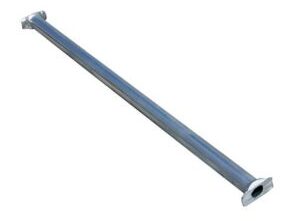
Ledgers are horizontal tubes that connect between the standards. They support the ledgers and are required for even load distribution all across scaffolding.
Braces:
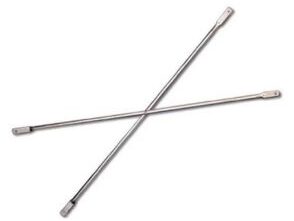
Braces are diagonal tubes fixed to the standards and ledgers. They stabilize the scaffold and protect it from lateral forces.
Putlogs:

Putlogs are small horizontal tubes that extend from the wall to the standards or between the standards. In double scaffolding, putlogs mainly support working platforms, and their ends are supported by ledgers.
Planks/Boards:
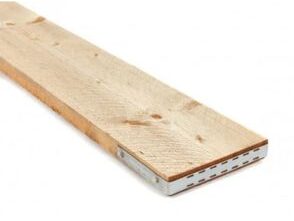
Planks or boards are usually wood and metal. They are spread across putlogs or ledgers to serve as a working platform that safely holds workers and tools and offers them a stable area for work and movement.
Base Plates:
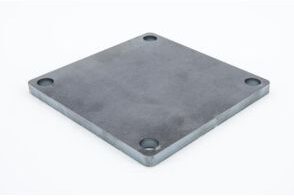
Base plates are steel flat plates installed under the stands to distribute the load and keep the scaffold stable. These base plates provide a firm and flat surface for the rests to rest on. They are placed under the standards on soft and uneven ground.
Guardrails:
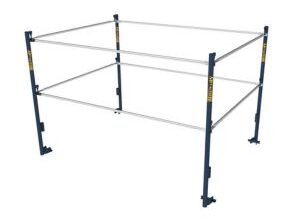
Guardrails are a safety component of double scaffolding. They are installed around the scaffolding platform’s edges to prevent injuries and accidental falls. Safety guardrails serve as barriers between workers and the scaffold perimeter.
What is the Difference Between Double and Single Scaffolding?
Here is a table describing the main points of difference between double and single scaffolding:
| Double Scaffolding | Single Scaffolding |
| Used in stone masonry | Used for brick masonry |
| The structure consists of a single row of standard, ledger, and putlogs | The structure consists of a single row of standard, ledger and putlogs |
| The structure consists of two rows of standards where the inner and outer rows parallel to the wall | Independent support due to the outer row that offers additional support |
| More stable, and doesn’t require wall support | Less stable, and always require wall support |
| Wall-support needed. Putlogs are placed into the holes left in the wall | More stable as has an additional row of standards alongside extra components like braces |
| Used mainly for stone masonry and when wall holes are difficult or impractical | Less stable, it relies partly on the wall. |
| Used for brick masonry and in every project where wall support is needed. | Easy construction, few components and parts need to be put together |
| Heavy low capacity due to additional supports | Suitable for light-weight tasks |
| Require more time for setup because additional components and standards need to assemble | Less durable and suitable for small to medium-height project |
| Complex construction, needs careful planning, skilled labor, and more material | More durable, ideal for taller structures and long-term projects |
| Require less time for setup as few components need to be put together | Less versatile, used in limited projects. |
| More safer because of double standards and double ledgers | Highly versatile and used for various construction scenarios, especially where wall integrity is a big concern |
| Cost-effective, and requires a few parts and components to build. | High initial cost and investment as multiple components, parts, and materials are required |






